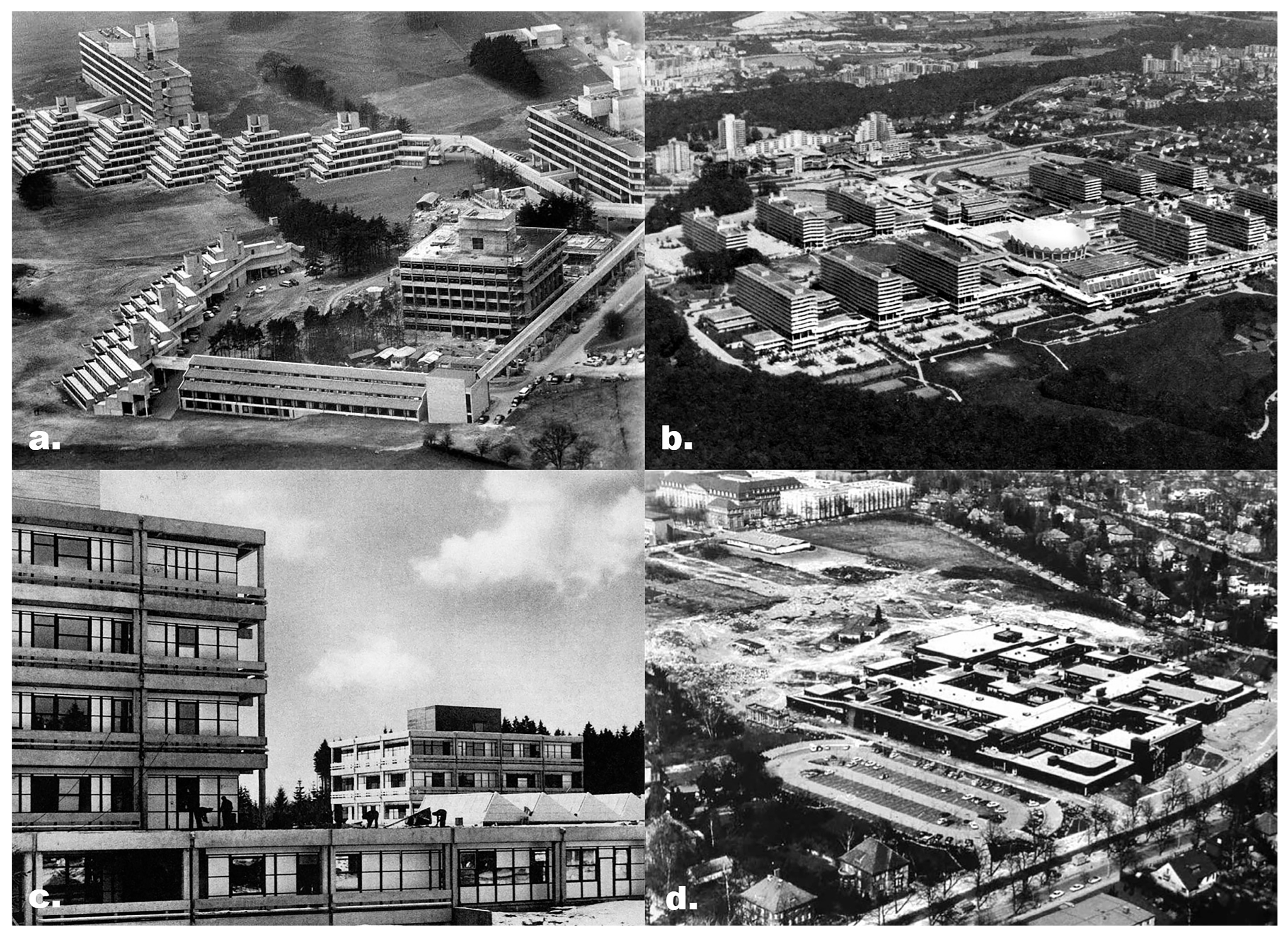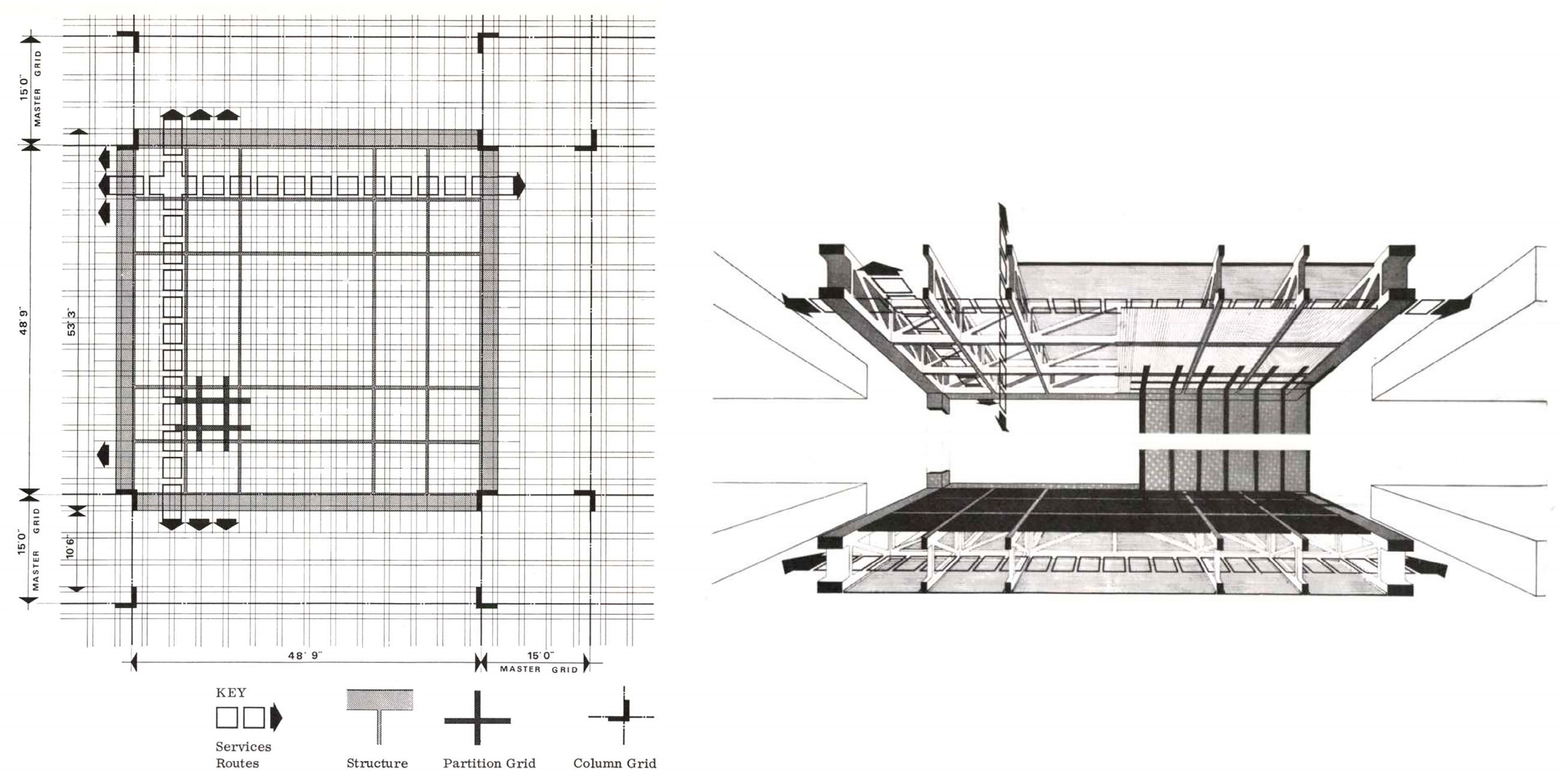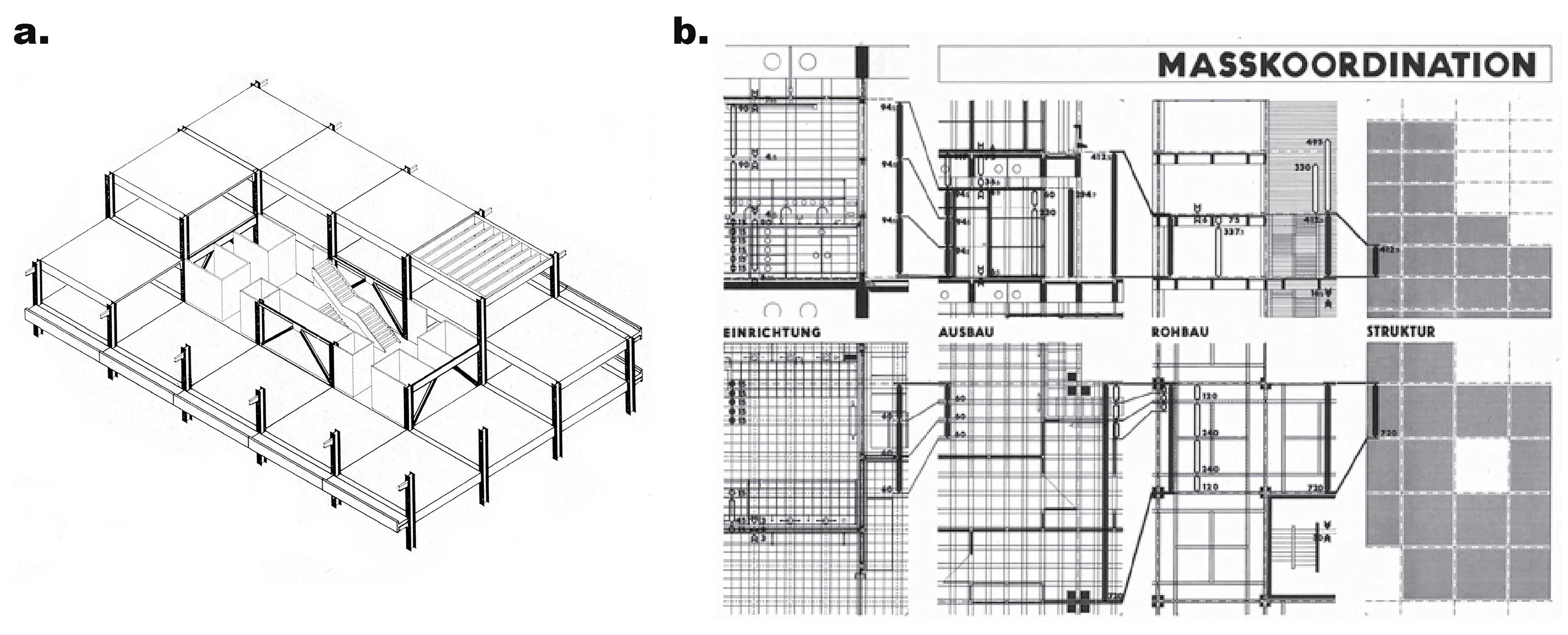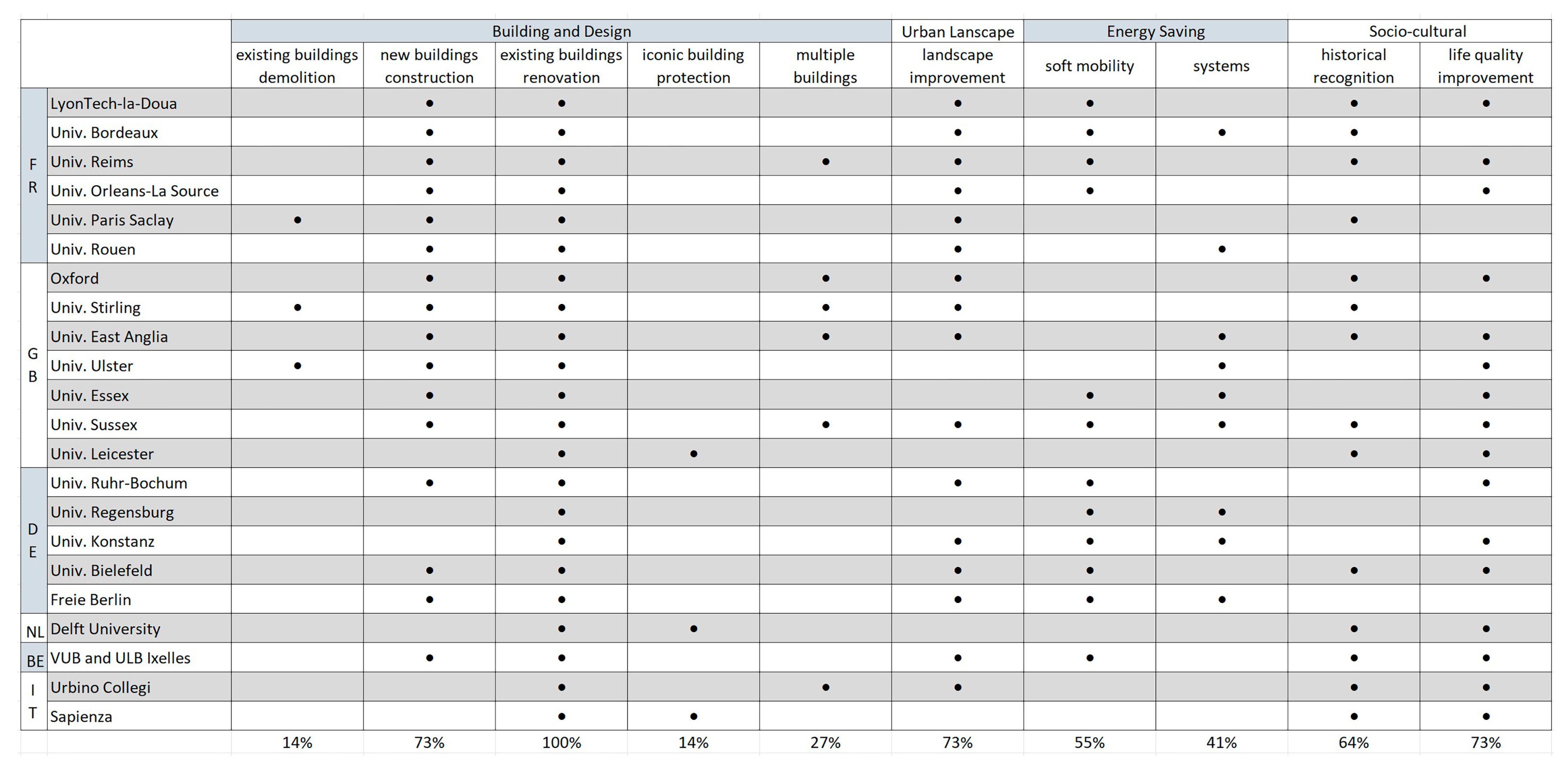Preserving Europe’s Post-War University Buildings: Towards Integrated Conservation and Management Plans
Abstract
1. Introduction
1.1. The Rise and Fall of Post-Second World War University Design
1.2. Risks and Challenges in Today’s Management and Conservation
2. Materials and Methods
3. Results
3.1. The Nature of the Plans
3.2. The Objectives of the Plans
4. Discussion
5. Conclusions
Author Contributions
Funding
Data Availability Statement
Conflicts of Interest
Abbreviations
| CMP | Conservation and Management Plan |
| SPSI | Schéma Pluriannuel de Stratégie Immobolière |
References
- Banham, R. Megastructure: Urban Futures of the Recent Past; Thames & Hudson Ltd.: London, UK, 1981; ISBN 0500272050. [Google Scholar]
- Schofer, E.; Meyer, J.W. The Worldwide Expansion of Higher Education in the Twentieth Century. Am. Sociol. Rev. 2005, 70, 898–920. [Google Scholar] [CrossRef]
- Campbell, L. Building on the Backs: Basil Spence, Queens’ College Cambridge and University Architecture at Mid-Century. Archit. Hist. 2011, 54, 383–405. [Google Scholar] [CrossRef]
- Jaspers, K.; Rossmann, K. Die Idee der Universität. In Für die Gegenwärtige Situation Entworfen; Springer: Berlin, Germany, 1961; ISBN 0000204064. [Google Scholar] [CrossRef]
- Johnson, W.J. Campus planning for growth. Landsc. Archit. Mag. 1964, 54, 208–216. [Google Scholar]
- Birks, T.; Holford, M. Building the New Universities; Clarke Doble & Brendon Ltd.: Plymouth, UK, 1972; ISBN 0715354760. [Google Scholar]
- Coppola D’Anna Pignatelli, P. L’università in espansione. In Orientamenti Dell’edilizia Universitaria; Etas Kompass: Milano, Italy, 1969. [Google Scholar]
- Muthesius, S. The Postwar University: Utopianist Campus and College; Yale University Press: New Haven, CT, USA, 2000; ISBN 0300087179. [Google Scholar]
- De Carlo, G. (Ed.) Pianificazione e Disegno Delle Università; Edizioni Universitarie Italiane: Roma, Italy, 1968. [Google Scholar]
- Hashimshony, R.; Haina, J. Designing the University of the Future. In The Translational Design of Universities; Kenn, F., Ed.; Brill Sense: Boston, MA, USA, 2019; pp. 51–70. [Google Scholar] [CrossRef]
- Langenberg, S. Open as a matter of principle. Blanco 2021, 31, 116–121. [Google Scholar] [CrossRef]
- Curtis, W. Denys Lasdun: Architecture, City, Landscape; Phaidon: London, UK, 1994; ISBN 0714828718. [Google Scholar]
- Fawcett, W.; Thornburrow, K.; Saunders, J. Conservation Development Strategy for the University of East Anglia. In The Challenge of Change: Dealing with the Legacy of the Modern Movement; van den Heuvel, D., Mesman, M., Quist, W., Lemmens, B., Eds.; IOS Press: Amsterdam, The Netherlands; ISBN 978-1-58603-917-2.
- Jöchner, C. (Ed.) RUB: Brutal Schön; Uni-Bibliothek-Bochum: Bochum, Germany, 2020. [Google Scholar] [CrossRef]
- Langenberg, S. Das Marburger Bausystem. In Offenheit als Prinzip; Niggli: Sulgen, Switzerland, 2013; ISBN 978-3-7212-0882-5. [Google Scholar]
- Rehm, R.; Langenberg, S. Measure and Module of Helmut Spieker’s Marburg Building System 1960–1970. Nexus Netw. J. 2022, 25, 339–366. [Google Scholar] [CrossRef]
- Hnilica, S. Experiments with Megastuctures and Building Systems. University Building in the Federal Republic of Germany in the 1960s and 1970s. Archit. Hist. 2022, 10, 1–34. [Google Scholar] [CrossRef]
- Habermas, J.; Blazek, J.R. The Idea of the University—Learning Processes. New Ger. Crit. 1987, 41, 3–22. [Google Scholar] [CrossRef]
- Larkham, P.J. Institutions and urban form: The example of universities. Urban Morphol. 2000, 4, 63–77. [Google Scholar] [CrossRef]
- Bilgin, H.; Hyraj, D. Sustainable interventions in historic buildings: Case of Polytechnic University of Tirana. Energy Build. 2025, 343, 115921. [Google Scholar] [CrossRef]
- El-Darwish, I.I. Enhancing outdoor campus design by utilizing space syntax theory for social interaction locations. Ain Shams Eng. J. 2022, 13, 101524. [Google Scholar] [CrossRef]
- Briand, F.; Chauffray, C.; Briand, H.; Grande, D.; Charpentier, B. Optimiser & Rénover le Patrimoine Immobilier Universitaire. 2014. Available online: https://www.amue.fr/fileadmin/amue/patrimoine/guide-patrimoine-2014/guide-patrimoine-impression.pdf (accessed on 10 September 2025).
- Freie Universität Berlin. Sustainability Report. 2024. Available online: https://www.fu-berlin.de/sites/nachhaltigkeit/_media/kommunikation/2024_Sustainability-Report_eng.pdf (accessed on 11 September 2025).
- Del Curto, D.; Salvo, S. Planned Conservation of 20th-Century Architecture; Springer: Cham, Switzerland, 2024; ISBN 978-3-031-67817-2. [Google Scholar] [CrossRef]
- Galbiati, G.; Medici, F.; Graf, F.; Marino, G. Methodology for energy retrofitting of Modern Architecture. The case study of the Olivetti office building in the UNESCO site of Ivrea. J. Build. Eng. 2021, 44, 103378. [Google Scholar] [CrossRef]
- Galbiati, G.; Graf, F.; Marino, G.; Fürbringer, J. A modelling framework for modern heritage buildings energy simulation. J. Build. Eng. 2023, 80, 107973. [Google Scholar] [CrossRef]
- Graf, F.; Marino, G. Concerning the research “Material history of the built environment and the conservation project” (2008–2020), methodology and results. In History of Construction Cultures, 7th International Congress on Construction History (7ICCH 2021), Lisbon, Portugal, 12–16 July 2021; CRC Press: London, UK, 2021. [Google Scholar]
- Güler Nakıp, G.; Żmudzińska-Nowak, M.; Ballice, G. The Neglected Modern Architectural Heritage: Analysis of Housing Estates in the Second Half of the 20th Century from Izmir, Turkey, Case Study Area. Buildings 2024, 14, 3337. [Google Scholar] [CrossRef]
- Tu, H.-M. The Attractiveness of Adaptive Heritage Reuse: A Theoretical Framework. Sustainability 2020, 12, 2372. [Google Scholar] [CrossRef]
- Arfa, F.H.; Zijlstra, H.; Lubelli, B.; Quist, W. Adaptive Reuse of Heritage Buildings: From a Literature Review to a Model of Practice. Hist. Environ. Policy Pract. 2022, 13, 148–170. [Google Scholar] [CrossRef]
- Farjami, E.; Türker, Ö.O. The Extraction of Prerequisite Criteria for Environmentally Certified Adaptive Reuse of Heritage Buildings. Sustainability 2021, 13, 3536. [Google Scholar] [CrossRef]
- Graf, F.; Marino, G. La Cité du Lignon, 1963–1971-Etude Architecturale et Stratégies D’intervention; Infolio: Lausanne, Switzerland, 2022; ISBN 9782884742610. [Google Scholar]
- Karasu, B.M.; Ediz, Ö. The impact of subsequent additions on visual harmony in a designed campus: A fractal analysis of Bursa Uludağ University Görükle Campus. Ain Shams Eng. J. 2025, 16, 103459. [Google Scholar] [CrossRef]
- Giancarlo De Carlo “Collegi” in Urbino. Conservation Plan. 2018. Available online: https://www.bsa-fas.ch/media/filer/2020/urbino_conservation_plan_redu.pdf (accessed on 11 September 2025).
- Valorisation Immobilière, Vie de Campus & Territoire: Guide Méthodologique. 2018. Available online: https://services.dgesip.fr/fichiers/guide-patrimoine-janv2019-site_final.pdf (accessed on 11 September 2025).
- Sustainability Strategy. University of Regensburg. 2023–2027. 2023. Available online: https://www.uni-regensburg.de/fileadmin/user_upload/bilderkatalog/ordnungen-satzungen-richtlinien/nachhaltigkeitsstrategie-en.pdf (accessed on 11 September 2025).
- Carbon Management Plan. University of Essex. 2013. Available online: https://share.google/aocp0v10e2DzumjOP (accessed on 11 September 2025).
- Carbon Management Plan. University of Ulster. 2015. Available online: https://www.ulster.ac.uk/__data/assets/pdf_file/0017/121166/Carbon-Management-Plan.pdf (accessed on 11 September 2025).
- Sustainable Strategy Action Plan. University of Sussex. 2021. Available online: https://www.sussex.ac.uk/about/sustainable-university/policy-and-strategy/strategy-action-plan (accessed on 11 September 2025).
- Building Conservation Plan. University of Sussex. 2022. Available online: https://www.brighton-hove.gov.uk/sites/default/files/2022-01/Full%20Agreement%20%2B%20annexes%20-%20revised%202022.pdf (accessed on 11 September 2025).
- ARUP; University of Leicester. Engineering Building, Conservation and Management Plan. 2022. Available online: https://it.scribd.com/document/689865651/Engineering-Building-Conservation-Management-Plan (accessed on 11 September 2025).
- Salvo, S. (Ed.) The School of Mathematics at Rome’s University Campus: Gio Ponti, 1935; Sapienza University of Rome: Rome, Itali, 2022; ISBN 978-88-9377-233-4. [Google Scholar]
- de Jonge, W.; Kerkhoven, K.; Clarke, N. TU Delft Aula Conservation Management Plan; TU Delft: Amsterdam, The Netherlands, 2024; ISBN 978-94-6366-901-6. [Google Scholar]
- Nys, G. (Ed.) Etude de Définition Grand Plaine; Perspective Brussels: Brussels, Belgium, 2019; Available online: https://perspective.brussels/sites/default/files/documents/etudedefinitiongrandeplaine_fr.pdf (accessed on 11 September 2025).
- Simpson & Brown Architects. The University of Stirling Campus. Conservation Plan. 2009. Available online: https://www.oralhistory.stir.ac.uk/memorabilia/09-10_Conservation_Plan.pdf (accessed on 11 September 2025).
- Marchand, M. Diagnostic Patrimonial de l’OIN de Paris-Saclay. 2012. Available online: https://inventaire.iledefrance.fr/dossinventaire/publication/saclay-etablissements-scientifiques-synthese.pdf (accessed on 11 September 2025).
- Projet Stratégique LyonTech-la Doua 2025. Available online: https://www.universite-lyon.fr/le-projet-strategique-lyontech-la-doua-2025--5629.kjsp (accessed on 11 September 2025).
- Université de Bordeaux. Schéma Pluriannuel de Stratégie Immobilière, Période 2017–2021. Available online: https://www.u-bordeaux.fr/universite/notre-strategie/politique-immobiliere (accessed on 11 September 2025).
- Université de Reims. Schéma Pluriannuel de Stratégie Immobilière. 2023. Available online: https://www.univ-reims.fr/media-files/48991/deliberation-n-14-relative-au-schema-pluriannuel-de-strategie-immobiliere.pdf (accessed on 11 September 2025).
- Université d’Orléans. Schéma Pluriannuel de Stratégie Immobilière, 2023–2027. Available online: https://www.univ-orleans.fr/upload/public/2024-04/2024-3_Délibération%20PV%20CA_20240216_SPSI%202023-2027.pdf (accessed on 11 September 2025).
- Schéma Pluriannuel de Stratégie Immobilière de L’université de Rouen Normandie, Période 2017–2022. Available online: https://www.univ-rouen.fr/wp-content/uploads/2023/01/SPSI-URouen-Normandie-2017-2022-Amendé-janv-2019.pdf (accessed on 11 September 2025).
- Estates Services, University of Oxford, Conservation Plans. 2012. Available online: https://estates.admin.ox.ac.uk/conservation-plans (accessed on 11 September 2025).
- Hochschulentwicklungsplan der Ruhr-Universität Bochum, 2020–2025. Available online: https://uni.ruhr-uni-bochum.de/sites/uni.ruhr-uni-bochum.de/files/2020-12/HEP_2021_0.pdf (accessed on 11 September 2025).
- University of Konstanz: Shaping a Sustainable Future Together. Available online: https://yerun.eu/2021/04/university-of-konstanz-shaping-a-sustainable-future-together/ (accessed on 11 September 2025).
- Nachhaltigkeitsleitbild der Universität Bielefeld. Available online: https://www.uni-bielefeld.de/themen/nachhaltigkeit/nachhaltigkeitsleitbild/ (accessed on 11 September 2025).
- Ceravolo, R.; Faccio, P.; Bruschi, G.; Chiorino, C.; Lenticchia, E.; Matteini, I.; Pasqual, F.; Spanò, A. The Halls of Torino Esposizioni: From Conservation Management Planning to Future Use. In Planned Conservation of 20th-Century Architecture: Research in Italy and Brazil; Del Curto, D., Salvo, S., Eds.; SpringerBriefs in Applied Sciences and Technology; Springer Nature: Cham, Switzerland, 2024; pp. 77–89. [Google Scholar] [CrossRef]
- Cunha Ferreira, T.; Mendes, N.; Póvoas, R.F.; Lourenço, P.B. Assessment Methodology for Conservation Planning of Concrete Buildings: Ocean Swimming Pool (1960–2021) by Álvaro Siza in Portugal. Int. J. Archit. Herit. 2022, 18, 333–355. [Google Scholar] [CrossRef]
- Ramos, L.; Morais, M.; Azenha, M.; Masciotta, G.; Pereira, E.; Cunha Ferreira, T.; Lourenço, P.B. HeritageCARE: The new project for the preventive conservation of built cultural heritage in the South-West Europe. In Innovative Built Heritage Models. Reflections on Cultural Heritage Theories and Practices; Van Balen, K., Vandersande, A., Eds.; CRC Press: London, UK, 2018; pp. 135–145. [Google Scholar] [CrossRef]
- Vicente-Gilabert, C.; Del Espino Hidalgo, B.; Linares Gómez Del Pulgar, M. Bridging Heritage and Citizens: A Methodological Consultation-Based Approach. Hist. Environ. Policy Pract. 2024, 15, 221–247. [Google Scholar] [CrossRef]
- Vandesande, A.; Verstrynge, E.; Van Balen, K. (Eds.) Preventive Conservation—From Climate and Damage Monitoring to a Systemic and Integrated Approach, 1st ed.; CRC Press: London, UK, 2020. [Google Scholar] [CrossRef]
- Gruhler, K.; Schiller, G. Grey energy impact of building material recycling—A new assessment method based on process chains. Resour. Conserv. Recycl. Adv. 2023, 18, 200139. [Google Scholar] [CrossRef]
- Cramer, J.; Breitling, S. Architecture in Existing Fabric: Planning, Design, Building; Birkhäuser: Berlin, Germany, 2007. [Google Scholar] [CrossRef]
- Cui, H.; Wu, J. How Architectural Heritage Is Moving to Smart: A Systematic Review of HBIM. Buildings 2025, 15, 2664. [Google Scholar] [CrossRef]
- Liberotti, R.; Gusella, V. Parametric Modeling and Heritage: A Design Process Sustainable for Restoration. Sustainability 2023, 15, 1371. [Google Scholar] [CrossRef]







Disclaimer/Publisher’s Note: The statements, opinions and data contained in all publications are solely those of the individual author(s) and contributor(s) and not of MDPI and/or the editor(s). MDPI and/or the editor(s) disclaim responsibility for any injury to people or property resulting from any ideas, methods, instructions or products referred to in the content. |
© 2025 by the authors. Licensee MDPI, Basel, Switzerland. This article is an open access article distributed under the terms and conditions of the Creative Commons Attribution (CC BY) license (https://creativecommons.org/licenses/by/4.0/).
Share and Cite
Galbiati, G.; Graf, F.; Marino, G. Preserving Europe’s Post-War University Buildings: Towards Integrated Conservation and Management Plans. Buildings 2025, 15, 3824. https://doi.org/10.3390/buildings15213824
Galbiati G, Graf F, Marino G. Preserving Europe’s Post-War University Buildings: Towards Integrated Conservation and Management Plans. Buildings. 2025; 15(21):3824. https://doi.org/10.3390/buildings15213824
Chicago/Turabian StyleGalbiati, Giuseppe, Franz Graf, and Giulia Marino. 2025. "Preserving Europe’s Post-War University Buildings: Towards Integrated Conservation and Management Plans" Buildings 15, no. 21: 3824. https://doi.org/10.3390/buildings15213824
APA StyleGalbiati, G., Graf, F., & Marino, G. (2025). Preserving Europe’s Post-War University Buildings: Towards Integrated Conservation and Management Plans. Buildings, 15(21), 3824. https://doi.org/10.3390/buildings15213824






